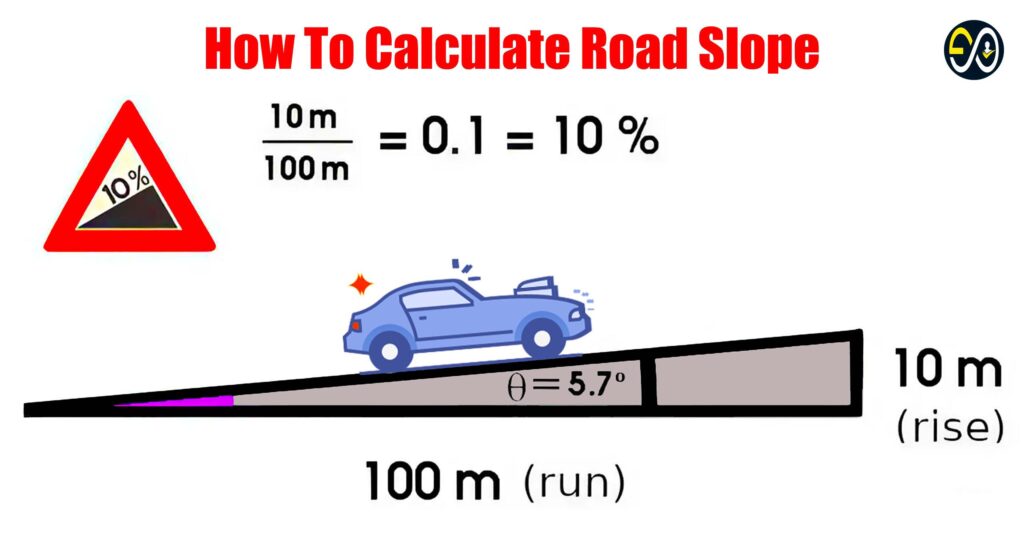
Road slope refers to the incline or decline of a road, which can significantly impact driving conditions and road safety. But, it’s how much the road tilts from a flat surface. If you’ve ever driven up a hill, you’ve experienced road slopes firsthand!
Table of Contents
Why is Road Slope Important?
The slope isn’t just about how tough it is to pedal uphill or how fast you coast downhill. It plays a crucial role in road design, drainage, and vehicle control. Engineers use road slopes to ensure proper water runoff, avoid excessive wear on vehicles, and, most importantly, make sure the road is safe for everyone.
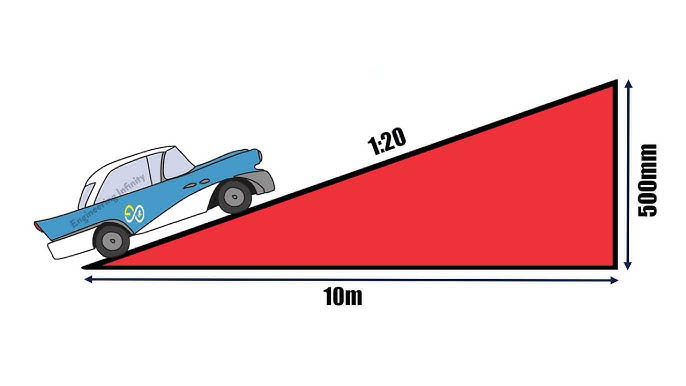
The formula for Slope Calculation
Slope (S) = (Vertical Rise / Horizontal Distance) x 100
This gives you the slope in percentage form. For example, if a road rises 5000mm over a distance of 100 meters, the slope would be:
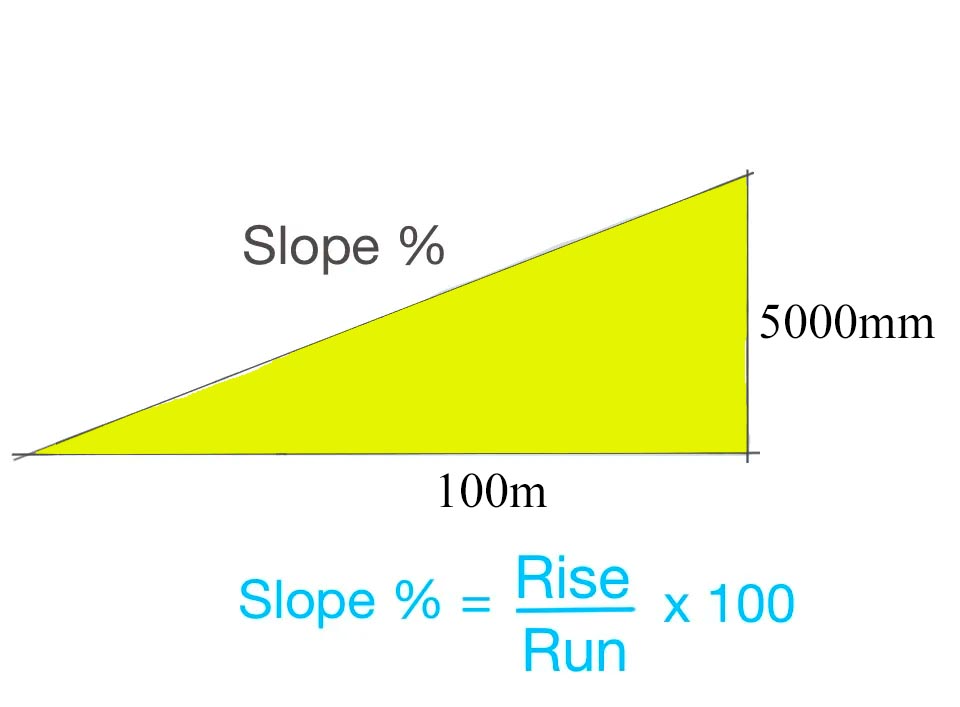
Convert the units: 5000mm = 5m
S = (5 / 100) x 100 = 5%
How to Measure Road Slope
Tools Needed for Measuring Slope
To measure slope, you don’t need complex machinery. You can use:
- A measuring tape or distance meter for horizontal distance.
- A level and a measuring rod for vertical rise.
- Alternatively, a clinometer or smartphone app can help.
Steps to Measure Road Slope Manually
- Mark the starting and ending points of the road section.
- Measure the vertical rise using the level and measuring rod.
- Measure the horizontal distance between the two points.
- Apply the slope formula to find the slope percentage.
Slope in Percentage vs. Slope in Degrees
Slope percentage refers to the ratio of vertical rise to horizontal distance. On the other hand, slope degrees express the angle between the road and a flat, horizontal surface. These two measurements are often confused but can be converted.
How to Convert Between Percentage and Degrees
Degrees = arctan(Slope Percentage / 100)
For example, a 10% slope would convert to approximately 5.71 degrees.
Types of Road Slopes
Uphill Slope (Positive Slope)
An uphill slope is when the road rises as you move forward. This can impact fuel efficiency as vehicles need more power to climb.

Downhill Slope (Negative Slope)
A downhill slope is the opposite, where the road descends. While you may not need to accelerate as much, downhill slopes can be tricky when it comes to braking.

Side Slope
Side slope refers to the tilt of the road to the left or right, often used for drainage purposes.
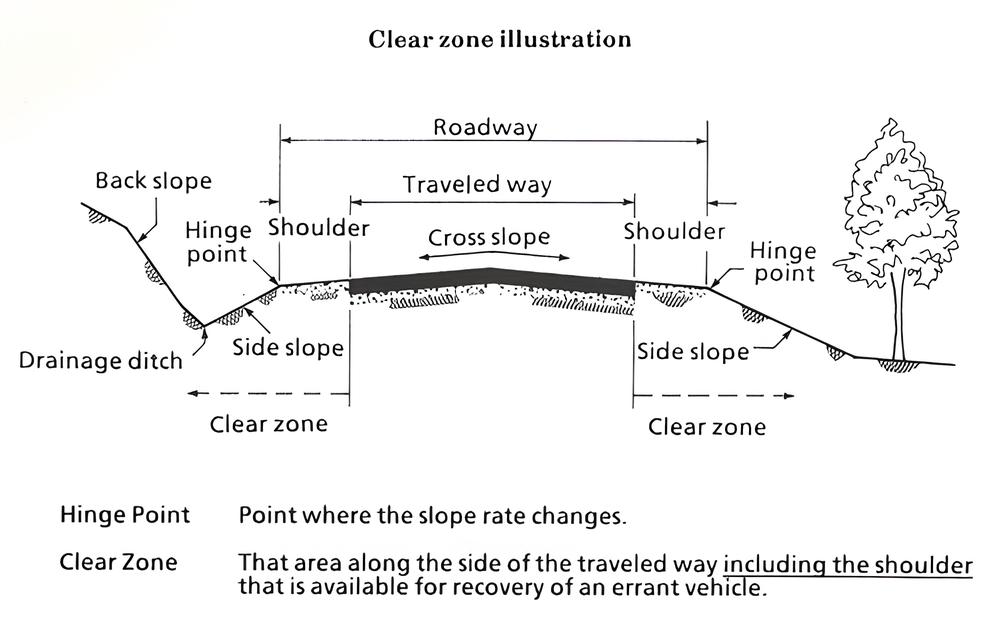
Why Is It Important to Calculate Road Slope?
Calculating the slope of a road serves several key purposes:
- Safety: A steep slope can make it difficult for vehicles to stop or accelerate properly, especially under adverse weather conditions.
- Drainage: Proper slope ensures that water flows off the road, preventing erosion and water pooling.
- Fuel Efficiency: The steeper the incline, the more fuel a vehicle consumes while ascending.
- Road Design: Engineers use road slope to ensure roads are built to appropriate standards and regulations, avoiding excessively steep inclines.
Maximum and Minimum Road Slope Standards
- Maximum Slope:
- Urban Roads/Highways: 6% to 8%, up to 10% in short sections.
- Mountain Roads: 10% to 12%, sometimes up to 15% in extreme cases.
- Bicycle Paths/Pedestrian Ramps: Max 5% to 8%.
- Minimum Slope:
- General Roads: 0.5% to 1% for proper drainage.
- Pedestrian/Bicycle Paths: 1% to 2% for accessibility and drainage.
In the table below you can see the different values of the road slope in different formats.
| Road slope [rise:run] | Road slope [%] | Slope angle [rad] | Slope angle [°] | sin(Slope angle) [-] | Road slope [rise/run] | Approximation Error [%] |
| 1:1 | 100 | 0.7854 | 45 | 0.7071 | 1 | 41.42 |
| 1:2 | 50 | 0.4636 | 26.57 | 0.4472 | 0.5 | 11.8 |
| 1:3 | 33.33 | 0.3218 | 18.43 | 0.3162 | 0.3333 | 5.41 |
| 1:4 | 25 | 0.245 | 14.04 | 0.2425 | 0.25 | 3.08 |
| 1:5 | 20 | 0.1974 | 11.31 | 0.1961 | 0.2 | 1.98 |
| 1:6 | 16.67 | 0.1651 | 9.46 | 0.1644 | 0.1667 | 1.38 |
| 1:7 | 14.29 | 0.1419 | 8.13 | 0.1414 | 0.1429 | 1.02 |
| 1:8 | 12.5 | 0.1244 | 7.13 | 0.124 | 0.125 | 0.78 |
| 1:9 | 11.11 | 0.1107 | 6.34 | 0.1104 | 0.1111 | 0.62 |
| 1:10 | 10 | 0.0997 | 5.71 | 0.0995 | 0.1 | 0.5 |
| 1:11 | 9.09 | 0.0907 | 5.19 | 0.0905 | 0.0909 | 0.41 |
| 1:12 | 8.33 | 0.0831 | 4.76 | 0.083 | 0.0833 | 0.35 |
| 1:13 | 7.69 | 0.0768 | 4.4 | 0.0767 | 0.0769 | 0.3 |
| 1:14 | 7.14 | 0.0713 | 4.09 | 0.0712 | 0.0714 | 0.25 |
| 1:15 | 6.67 | 0.0666 | 3.81 | 0.0665 | 0.0667 | 0.22 |
| 1:16 | 6.25 | 0.0624 | 3.58 | 0.0624 | 0.0625 | 0.2 |
| 1:17 | 5.88 | 0.0588 | 3.37 | 0.0587 | 0.0588 | 0.17 |
| 1:18 | 5.56 | 0.0555 | 3.18 | 0.0555 | 0.0556 | 0.15 |
| 1:19 | 5.26 | 0.0526 | 3.01 | 0.0526 | 0.0526 | 0.14 |
| 1:20 | 5 | 0.05 | 2.86 | 0.0499 | 0.05 | 0.12 |
| 1:21 | 4.76 | 0.0476 | 2.73 | 0.0476 | 0.0476 | 0.11 |
| 1:22 | 4.55 | 0.0454 | 2.6 | 0.0454 | 0.0455 | 0.1 |
| 1:23 | 4.35 | 0.0435 | 2.49 | 0.0434 | 0.0435 | 0.09 |
| 1:24 | 4.17 | 0.0416 | 2.39 | 0.0416 | 0.0417 | 0.09 |
| 1:25 | 4 | 0.04 | 2.29 | 0.04 | 0.04 | 0.08 |
| 1:26 | 3.85 | 0.0384 | 2.2 | 0.0384 | 0.0385 | 0.07 |
| 1:27 | 3.7 | 0.037 | 2.12 | 0.037 | 0.037 | 0.07 |
| 1:28 | 3.57 | 0.0357 | 2.05 | 0.0357 | 0.0357 | 0.06 |
| 1:29 | 3.45 | 0.0345 | 1.97 | 0.0345 | 0.0345 | 0.06 |
| 1:30 | 3.33 | 0.0333 | 1.91 | 0.0333 | 0.0333 | 0.06 |
| 1:31 | 3.23 | 0.0322 | 1.85 | 0.0322 | 0.0323 | 0.05 |
| 1:32 | 3.13 | 0.0312 | 1.79 | 0.0312 | 0.0313 | 0.05 |
| 1:33 | 3.03 | 0.0303 | 1.74 | 0.0303 | 0.0303 | 0.05 |
| 1:34 | 2.94 | 0.0294 | 1.68 | 0.0294 | 0.0294 | 0.04 |
| 1:35 | 2.86 | 0.0286 | 1.64 | 0.0286 | 0.0286 | 0.04 |
| 1:36 | 2.78 | 0.0278 | 1.59 | 0.0278 | 0.0278 | 0.04 |
| 1:37 | 2.7 | 0.027 | 1.55 | 0.027 | 0.027 | 0.04 |
| 1:38 | 2.63 | 0.0263 | 1.51 | 0.0263 | 0.0263 | 0.03 |
| 1:39 | 2.56 | 0.0256 | 1.47 | 0.0256 | 0.0256 | 0.03 |
| 1:40 | 2.5 | 0.025 | 1.43 | 0.025 | 0.025 | 0.03 |
| 1:41 | 2.44 | 0.0244 | 1.4 | 0.0244 | 0.0244 | 0.03 |
| 1:42 | 2.38 | 0.0238 | 1.36 | 0.0238 | 0.0238 | 0.03 |
| 1:43 | 2.33 | 0.0233 | 1.33 | 0.0232 | 0.0233 | 0.03 |
| 1:44 | 2.27 | 0.0227 | 1.3 | 0.0227 | 0.0227 | 0.03 |
| 1:45 | 2.22 | 0.0222 | 1.27 | 0.0222 | 0.0222 | 0.02 |
| 1:46 | 2.17 | 0.0217 | 1.25 | 0.0217 | 0.0217 | 0.02 |
| 1:47 | 2.13 | 0.0213 | 1.22 | 0.0213 | 0.0213 | 0.02 |
| 1:48 | 2.08 | 0.0208 | 1.19 | 0.0208 | 0.0208 | 0.02 |
| 1:49 | 2.04 | 0.0204 | 1.17 | 0.0204 | 0.0204 | 0.02 |
| 1:50 | 2 | 0.02 | 1.15 | 0.02 | 0.02 | 0.02 |
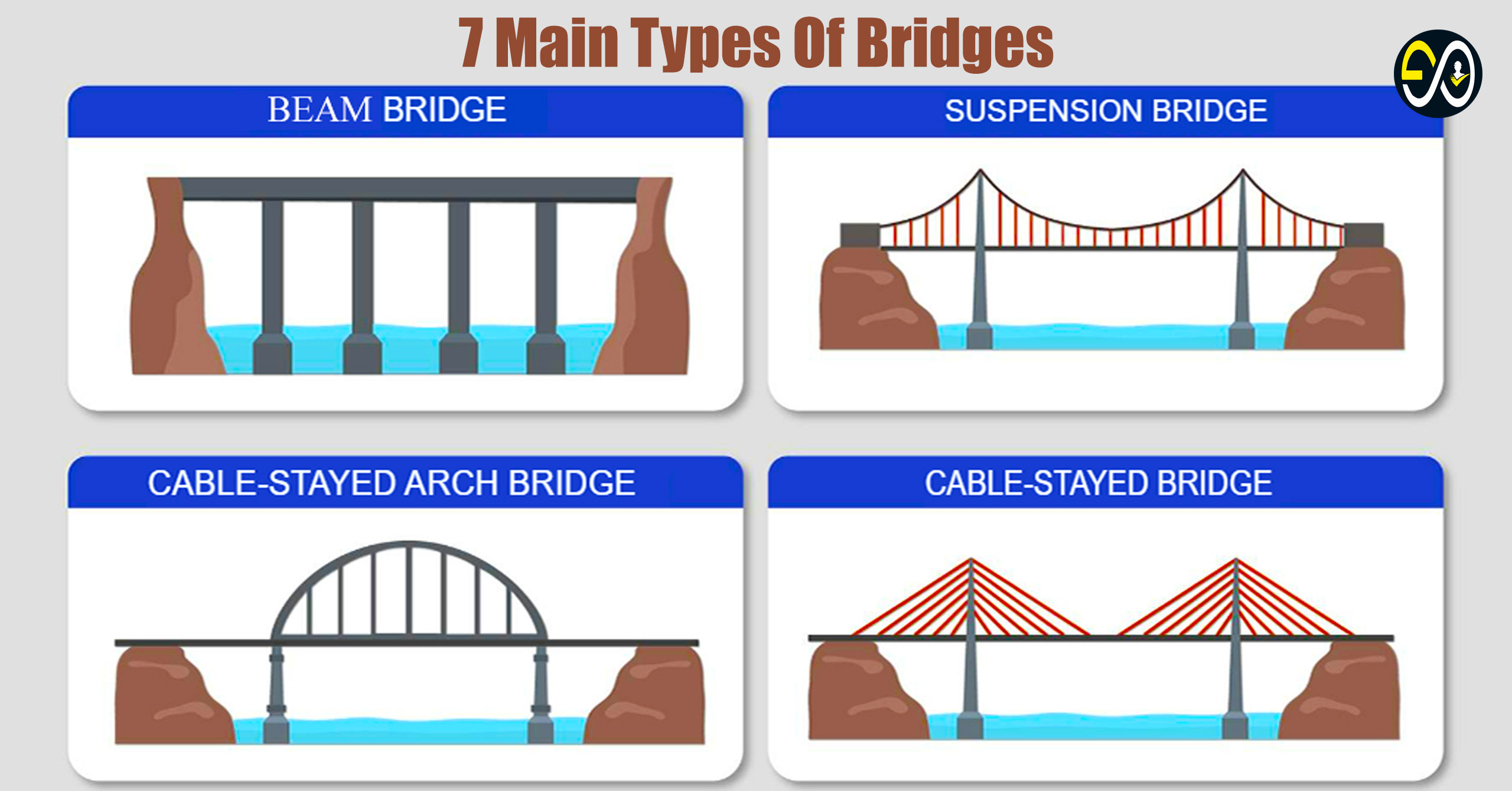


This’s a very good piece I have seen this week and it has added and refreshed my knowledge on a few things.
thanks very much.
I had wished I could get a pdf version and I would be glad for it.